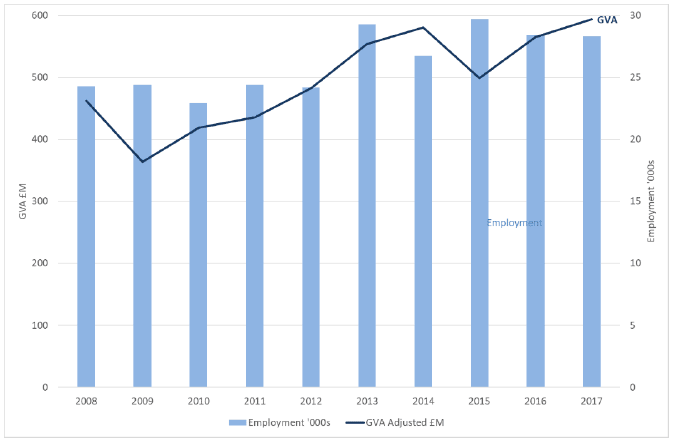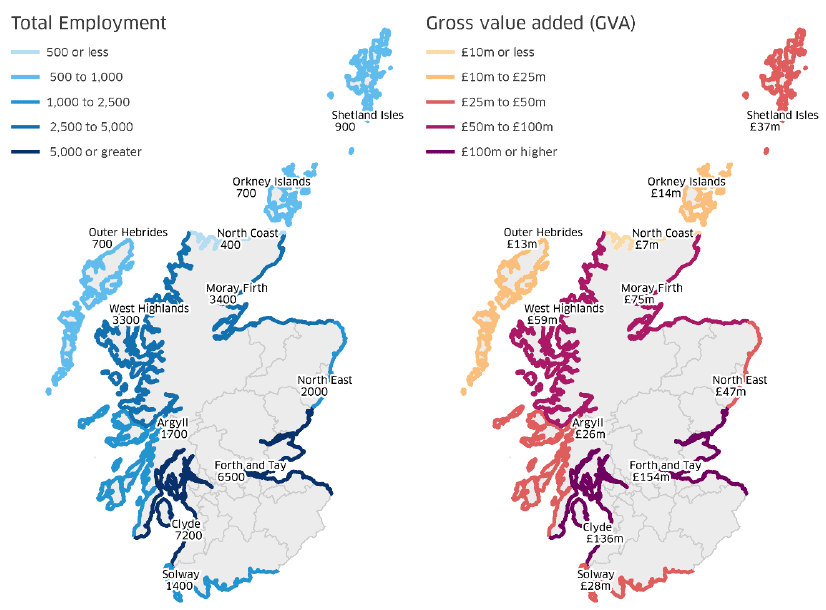Marine economic statistics 2017: corrected April 2020
Statistics on economic contributions of Scotland’s marine sectors present a time series of Gross Value Added (GVA), turnover and employment for industrial categories defined as part of the marine sector. This publication was originally published in October 2019 and was corrected in April 2020.
11. Marine Tourism and Recreation
11.1 Introduction
In 2017, Marine Scotland developed the methodology for estimating marine tourism and recreation, separately from all tourism. This is based on SABS SIC codes used in the SABS reporting on Sustainable Tourism growth sectors[11] and where businesses are located in postcodes within 100 metres of the coastline. While this may include some businesses that are not marine-related, and not include some that are marine-related, it provides a reasonable and replicable method of estimating the economic contributions of marine tourism and recreation businesses using existing data.
11.2 Key economic points
In 2017 marine tourism generated £594 million GVA: accounting for 0.45% of the overall Scottish economy and 12% of the marine economy GVA.
The marine tourism industry provided employment for 28,300 people (headcount), contributing 1.14% of the total Scottish employment. It is the biggest marine economy employer accounting for 38% of the marine economy employment. The figures in this report are headcounts so while marine tourism and recreation dominates marine economy employment figures, the full time equivalent employment will be significantly smaller because of the seasonal nature of tourism and recreation and the part time nature of the employment.
Scottish tourism as a whole was estimated to be worth £4.1 billion in GVA in 2017. Thus marine tourism is estimated to account for around 14% of all Scottish tourism, which is similar to the 2016 figure.
11.3 Marine tourism - trends
From 2016 to 2017, the GVA from marine tourism (adjusted to 2017 prices) increased by 5%, while the longer term trend from 2008 to 2017 showed that marine tourism GVA increased by 28%.
From 2008 to 2017, employment increased by 16%.
| Year | GVA £M |
Turnover £M |
Employment Headcount 000's |
GVA Per Head £ |
|---|---|---|---|---|
| 2008 | 462 | 910 | 24.3 | 19,028 |
| 2009 | 364 | 762 | 24.4 | 14,915 |
| 2010 | 419 | 847 | 22.9 | 18,289 |
| 2011 | 436 | 888 | 24.4 | 17,850 |
| 2012 | 482 | 956 | 24.2 | 19,929 |
| 2013 | 554 | 1,016 | 29.3 | 18,897 |
| 2014 | 580 | 1,034 | 26.7 | 21,730 |
| 2015 | 499 | 932 | 29.7 | 16,800 |
| 2016 | 565 | 1,050 | 28.4 | 19,900 |
| 2017 | 594 | 1,018 | 28.3 | 20,989 |

11.4 Marine tourism by geography
The marine tourism economic values were disaggregated to Scottish Marine Regions (attribution by local authority is partially disclosive due to the small quantity of data). While SMRs are geographies that relate to the sea, marine tourism is earned on land and so Figure 19 shows outputs around the coast.
The Forth and Tay region was the largest contributor to marine tourism GVA in 2017 at £154 million (26% of the GVA), while the Clyde region contributed 7,200 jobs, (26% of the employment), which was slightly higher than the Forth and Tay.
| SMR | GVA £M |
Turnover £M |
Headcount '000s |
|---|---|---|---|
| Forth and Tay | 154 | 254 | 6.5 |
| Clyde | 136 | 245 | 7.2 |
| Moray Firth | 75 | 127 | 3.4 |
| West Highlands | 59 | 94 | 3.3 |
| North East | 47 | 84 | 2.0 |
| Shetland Isles | 37 | 66 | 0.9 |
| Solway | 28 | 47 | 1.4 |
| Argyll | 26 | 45 | 1.7 |
| Orkney Islands | 14 | 22 | 0.7 |
| Outer Hebrides | 13 | 24 | 0.7 |
| North Coast | 7 | 10 | 0.4 |
| Grand Total | 594 | 1,018 | 28.3 |

Scottish Government (Marine Scotland) 2019
Contains National Statistics data ©
Crown copyright and database right
Contact
Email: Venetia.Haynes@gov.scot
There is a problem
Thanks for your feedback